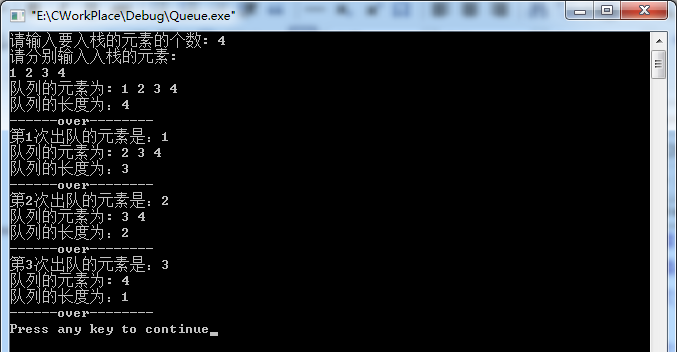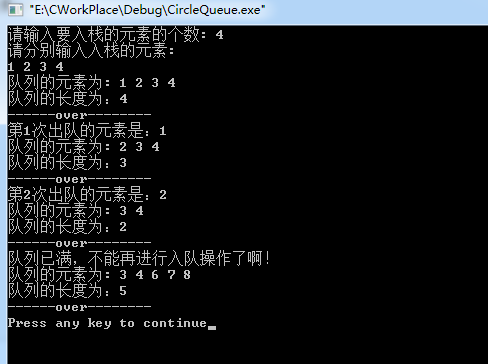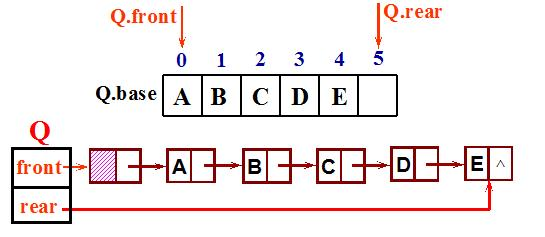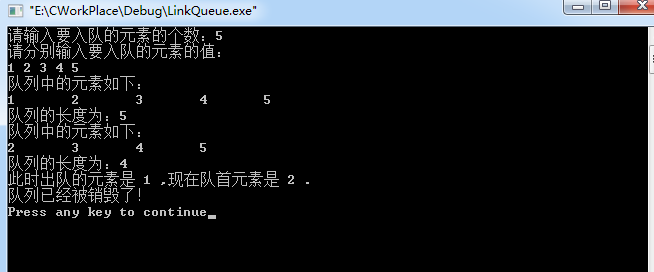队列是一种只允许在一端进行插入,而在另一端进行删除的线性表,它是一种操作受限制的线性表,在该表中只允许插入的一端称为队尾(rear),二另一端只允许删除的一端称为队首(front)。
一、队列的顺序存储
队列的顺序存储结构就可以称为顺序队列,也就是利用一组地址连续的存储单元将元素依次存放在队列中。如图:

由上图可知可以先写出其数据类型
typedef struct queue
{
ElemType elem[MAXSIZE];
int front;
int rear;
}queue;
其中的MAXSIZE指明的是队列中的存储容量的大小,队列初始化时,将队尾的索引与队首的索引都相同且置为-1
void Init_queue(queue *Q)
{
Q->front=-1;
Q->rear=-1;
}
这个时候就可以进行一系列的操作了,如下:
#include<stdio.h>
#define MAXSIZE 10
typedef int ElemType;
typedef struct queue
{
ElemType elem[MAXSIZE];
int front;
int rear;
}queue;
void Init_queue(queue *Q)
{
Q->front=-1;
Q->rear=-1;
}
int Empty_queue(queue Q)
{
if(Q.front==Q.rear)
return 1;
else
return 0;
}
int Full_queue(queue Q)
{
if(Q.rear>=MAXSIZE-1)
return 1;
else
return 0;
}
int QueueLength(queue Q)
{
return Q.rear-Q.front;
}
int EnQueue(queue *Q,ElemType x)
{
if(Full_queue(*Q))
return 0;
Q->elem[++Q->rear]=x;
return 1;
}
int DeQueue(queue *Q,ElemType *x)
{
if(Empty_queue(*Q))
return 0;
else
{
*x=Q->elem[++Q->front];
return 1;
}
}
void QueuePrint(queue Q)
{
int i;
printf("队列的元素为: ");
for(i=Q.front+1;i<=Q.rear;i++)
printf("%d ",Q.elem[i]);
printf("\n队列的长度为:%d\n------over--------\n",QueueLength(Q));
}
void main()
{
queue Q;
Init_queue(&Q);
int n,i=0; //n是要入栈的元素的个数
printf("请输入要入栈的元素的个数: ");
scanf("%d",&n);
while(n>MAXSIZE || n<1){
printf("队列容量有限(默认为%d),%d不符合要求,请重新输入\n",MAXSIZE,n);
}
ElemType x;
printf("请分别输入入栈的元素:\n");
for(i=0;i<n;i++)
{
scanf("%d",&x);
EnQueue(&Q,x);
}
QueuePrint(Q);
//出队操作
for(i=1;i<n;i++)
{
DeQueue(&Q,&x);
printf("第%d次出队的元素是:%d\n",i,x);
QueuePrint(Q);
}
}
运行结果如图:

二、循环队列
在顺序队列中,当队尾指针指向了队列中的最后一个元素的位置的时候,此时若有元素入队列,就会发生“溢出”,此时假设即便有两个元素出队了,虽然有两个看位置,但是其队尾指针的位置与队首指针之间没有关系,所以还是无法腾出位置给其他元素,可以称这种现象为假溢出现象。

解决该办法有两种:
(1)、采用平移的方法,当发生假溢出的时候将整个队列平移至存储区的首部,然后在插入元素。这样做的需要移动大量元素,因而效率是很低的。
(2)、将顺序队列的存储区假设为一个环状的空间,如图:


程序实现如下:
#include<stdio.h>
#include<stdlib.h>
#define N 6
typedef int ElemType;
typedef struct queue
{
ElemType *data;
int front;
int rear;
}queue;
void Init_queue(queue *Q)
{
//开辟连续的存储空间作为队列的存储容量
Q->data=(ElemType *)malloc(N*sizeof(ElemType));
Q->front=-1;
Q->rear=-1;
}
int Empty_queue(queue Q)
{
if(Q.front==Q.rear)
return 1;
else
return 0;
}
int Full_queue(queue Q)
{
if((Q.rear+1)%N==Q.front)
{
printf("队列已满,不能再进行入队操作了啊!\n");
return 1;
}
else
return 0;
}
int Length_queue(queue Q)
{
return (Q.rear+N-Q.front)%N;
}
int En_queue(queue *Q,ElemType x)
{
if(Full_queue(*Q))
return 0;
Q->rear=(Q->rear+1)%N;
Q->data[Q->rear]=x;
return 1;
}
int De_queue(queue *Q,ElemType *x)
{
if(Full_queue(*Q))
return 0;
Q->front=(Q->front+1)%N;
*x=Q->data[Q->front];
}
void QueuePrint(queue Q)
{
int i;
printf("队列的元素为: ");
if(Q.rear<Q.front)
Q.rear+=N;
for(i=Q.front+1;i<=Q.rear;i++)
printf("%d ",Q.data[i%N]);
printf("\n队列的长度为:%d\n------over--------\n",Length_queue(Q));
}
void main()
{
queue Q;
Init_queue(&Q);
int n,i=0; //n是要入栈的元素的个数
printf("请输入要入栈的元素的个数: ");
scanf("%d",&n);
while(n>N || n<1){
printf("队列容量有限(默认为%d),%d不符合要求,请重新输入\n",N,n);
}
ElemType x;
printf("请分别输入入栈的元素:\n");
for(i=0;i<n;i++)
{
scanf("%d",&x);
En_queue(&Q,x);
}
QueuePrint(Q);
/*现在模拟已经输入队列四个元素,出队列两个元素后,如果是前面的顺序队列,
则只能继续入對两个元素,若是循环队列,则可以继续入队四个元素*/
//出队两个元素
for(i=0;i<=1;i++)
{
De_queue(&Q,&x);
printf("第%d次出队的元素是:%d\n",i+1,x);
QueuePrint(Q);
}
//入四个元素到队列中去
for(i=6;i<=9;i++)
En_queue(&Q,i);
QueuePrint(Q);
}
运行结果如图:

三、队列的链式存储
在一个链队列中,设定两个指针(头指针和尾指针),分别指向队列的头和尾,类比线性表,给队列链添加一个头结点,并设定头指针指向头结点。结构如图:

即队列链表的结构体如下:
typedef struct Qnode{
ElemType data;
struct Qnode *next;
}Qnode;
typedef struct {
Qnode *front;
Qnode *rear;
}
类比上面的图片可以写出如下形式的完整代码:
#include<stdio.h>
#include<stdlib.h>
typedef int ElemType;
typedef struct Qnode{
ElemType data;
struct Qnode *next;
}Qnode;
typedef struct {
Qnode *front;
Qnode *rear;
}LinkQueue;
void Init_queue(LinkQueue *Q)
{
Q->front=Q->rear=(Qnode*)malloc(sizeof(Qnode));
if(!(Q->front)){
printf("头结点的存储空间开辟失败!\n");
exit(0);
}
Q->front->next=NULL;
}
void Destory_Queue(LinkQueue *Q)
{
while(Q->front)
{
Q->rear=Q->front->next;
free(Q->front);
Q->front=Q->rear;
}
printf("队列已经被销毁了!\n");
}
int Empty_queue(LinkQueue Q)
{
if(Q.front==Q.rear)
return 1;
else
return 0;
}
int QueueLength(LinkQueue Q)
{
Qnode *p=Q.front;
int n=0;
while(p!=Q.rear)
{
n++;
p=p->next;
}
return n;
}
ElemType Get_head(LinkQueue Q)
{
if(Q.front!=Q.rear)
return Q.front->next->data;
else
return 0;
}
void En_queue(LinkQueue *Q,ElemType x)
{
Qnode *p=(Qnode*)malloc(sizeof(Qnode));
if(!p)
{
printf("新节点开辟失败!\n");
exit(0);
}
p->data=x;
p->next=NULL;
if(Q->rear==NULL)
//头结点,起始时头结点和尾结点指向同一个元素
Q->rear=p;
else
{
Q->rear->next=p;
Q->rear=p;
}
}
void De_queue(LinkQueue *Q,ElemType *x)
{
Qnode *p;
if(Q->front!=Q->rear)
{
//队列非空
p=Q->front->next; //Q->front代表的是链表的头结点,是一个空节点
Q->front->next=p->next;
*x=p->data;
if(Q->rear==p)
Q->rear=Q->front;
free(p);
}
}
void Print_queue(LinkQueue Q)
{
Qnode *p;
printf("队列中的元素如下:\n");
if(Q.front==NULL){
printf("队列为空!没有元素。");
return;
}
p=Q.front->next;
while(p)
{
printf("%d\t",p->data);
p=p->next;
}
printf("\n队列的长度为:%d\n",QueueLength(Q));
}
void main()
{
LinkQueue Q;
Init_queue(&Q);
int n,i;
ElemType x,e;
printf("请输入要入队的元素的个数:");
scanf("%d",&n);
printf("请分别输入要入队的元素的值:\n");
for(i=0;i<n;i++)
{
scanf("%d",&x);
En_queue(&Q,x);
}
Print_queue(Q);
//元素出队
De_queue(&Q,&x);
Print_queue(Q);
e=Get_head(Q);
printf("此时出队的元素是 %d ,现在队首元素是 %d .\n",x,e);
//销毁队列
Destory_Queue(&Q);
}
运行结果如图:





















 1万+
1万+

 被折叠的 条评论
为什么被折叠?
被折叠的 条评论
为什么被折叠?








